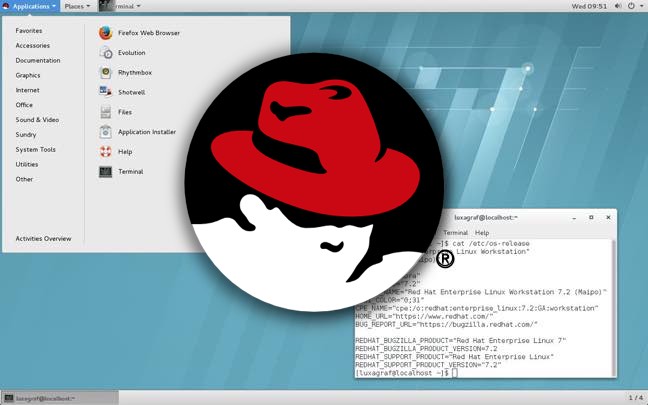

- #Redhat linux distro for free
- #Redhat linux distro software
- #Redhat linux distro code
- #Redhat linux distro series
- #Redhat linux distro download
If you know, GNOME 40 is the latest version of the GNOME desktop environment that arrived last month. This is because Fedora regularly updates the packages to their latest version to provide an up-to-date OS after every six months. Even though Fedora does not follow the rolling release model, it is the distribution known for offering bleeding-edge technology early on. When it comes to innovation and new technologies, Fedora takes a complete edge over the RHEL. Each major release of Red Hat goes through four lifecycle phases that range from 5 years of support to 10 years with Extended Life Phase using add-on subscriptions.
#Redhat linux distro series
Red Hat releases a new point version of a particular series every year and a major version after approximately 5 years. Release Cycleįor delivering the regular updates to all components of the OS, both RHEL and Fedora follow a standard fixed-point release model.įedora has a new version release approximately every six months (mostly in April and October) that comes with maintenance support for up to 13 months. In another way, Fedora Linux acts as a testing ground for Red Hat to first check and then incorporate features into the RHEL system.
#Redhat linux distro code
Of course, Red Hat also test the pulled code before merging into its own codebase for RHEL. This means when a new version of Fedora releases with new features and changes, Red Hat makes use of Fedora source code to include the desired features in its next release. Upstream vs Downstreamįedora is upstream of RHEL and RHEL is downstream of Fedora. This comes with Red Hat customer support. You have to pay more than $100 to purchase other RHEL versions for servers, virtual datacenters, and desktops. If you want the entire RHEL developer suite, it costs $99 per year.
#Redhat linux distro for free
You may get Red Hat for free by registering for its developer program. Red Hat Enterprise Linux is one such popular Linux-based operating system that comes at cost of money. There are still Linux distros for which you have to pay. Fedora Linux is also one such distro, whose desktop, server, all other editions, and spins are freely available to download.
#Redhat linux distro download
Well, you will find the majority of Linux distributions are available to download free of cost. Unlike Red Hat, Fedora is a community version of the Linux distribution that is available at free of cost for everyone including bug fixes and other services.Įven though Red Hat sponsors the Fedora Project, Fedora Linux is primarily maintained by an independent open source community. Even all software, bug fixes, and security support are available for only those who have an active Red Hat subscription.Īt the time when Red Hat Linux became RHEL, it also resulted in the foundation of the Fedora Project that takes care of the development of Fedora Linux. While Debian and Ubuntu are very popular distributions of software, Red Hat is doing far more development (often, "most" is a fair assessment.What it means is that you have to subscribe and pay to use Red Hat as it is not available as a free OS. These trends are pretty consistent up and down the stack. But the next "by affiliation" graph counts the number of commits, and in that one, is much smaller, and is much larger: In that one, canonical and have a healthy showing. Note that the first "by affiliation" graph is a count of contributors by email address. Here's a recent report on GNOME development.

The Linux Foundation used to publish an annual report on development stats, but the most recent one I see is from 2017: I don't see a report on maintainer activity, but the Fedora maintainers group reports ~ 2000 members total. u/AiwendilH posted a link to Debian's page which indicates 1295 maintainers active this year.
#Redhat linux distro software
However, if you mean "people who re-package, build, and distribute the software in the distribution" then the largest groups are probably the Fedora and Debian maintainers. Code contribution surveys consistently identify Red Hat as one of the largest groups of developers contributing to almost all of the core OS components, from the kernel and glibc all the way up the stack to Pipewire, Wayland, and GNOME. If you mean "developers who work on the software in the distribution and the tooling around it," then it's very likely that Red Hat (and Fedora) are the answer.

We always hear about 'which distro has the most users' but imo the number of active developersĭo you mean developers, or package maintainers?


 0 kommentar(er)
0 kommentar(er)
